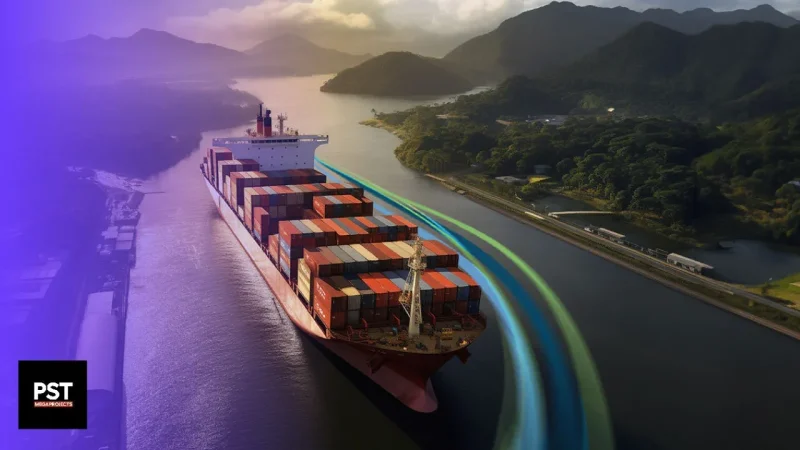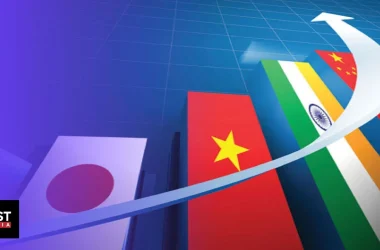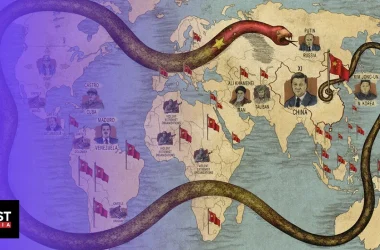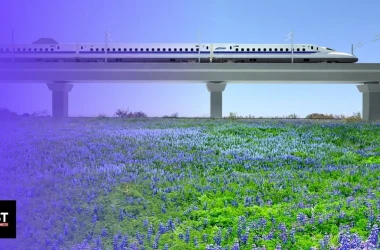Every year, billions of dollars worth of goods, nearly half of all US sea freight, and countless international trade pass through the Panama Canal. It’s a vital artery that connects the world’s oceans, and eases the movement of goods between continents.
But, there’s just one problem: it’s running out of water. The lack of water is reducing the number of ships that can pass through the canal each day, creating an enormous traffic jam as a result. With very few options left to save the Panama Canal, the time has come to look for a replacement.
Why is the Panama Canal Failing?
The Panama Canal as we see it today is the result of a US project that was completed in 1914. It opened a great deal of fanfare, since it was seen as an incredible triumph for an emerging world power.
Just like that, a new shipping route was created across a continent containing the largest dam and artificial lake in the world. But, its design, which was considered a stroke of genius at the time, has become its achilles heel now.
The series of locks at either end of the canal are crucial to its design, but it takes nearly 200 million liters of water to pass a ship through just one lock – greatly reducing the amount of water in the canal each time.
In 2015, the first sign that something was wrong emerged. A massive drought caused the authorities to declare a state of emergency and limit the size of ships allowed to pass through it. The canal often depends on rainfall to make up for its low water supply, but the 2015 drought brought with it the driest rainy season in over a century.
Then, in 2023, the canal saw the longest dry spell in its history. The water level in the canal was so low that the number of ships allowed to pass through it each day was reduced from 40 to 24. It reached a crisis point in August when an unbelievable traffic jam of 160 ships were left waiting to pass through the canal.
Besides restricting and reducing the number of ships being allowed through the canal, the government also restricted the ships from sailing at full capacity. For example, the largest class of ships, the neopanamax containers, were forced to carry 40% less cargo so they sat higher in the shallow water.
Canal authorities even started selling off slots in the canal to the highest bidder. After bidding to skip the queue, a tanker carrying liquefied natural gas paid $4 million on top of the usual $400,000 sailing fee.
Government Response
Rather than sit back and let the Panama Canal die off, the Panama Canal Authorities backed a plan to create a new reservoir for the canal last year. It was actually a plan devised in the late 1990s, and proposes creating an artificial lake by damming the Indio river. The water would then go to supplying Lake Gatun with fresh water via an eight-kilometer tunnel. This water would then feed into the Panama Canal through pre-existing channels.
But, there’s just one problem with this. A law from 2006 banned the canal’s authorities from constructing any more reservoirs. Meaning, for this plan to go ahead, that law would have to be overturned.
This won’t be easy, as Panama has been rocked by a series of protests against a controversial new mining operation. Many fear that it will have a massive impact on the country’s ecology and precarious supply of drinking water. Therefore, any plan for more construction will likely be met with similar opposition.
Megaprojects that can replace the Panama Canal
While the government of Panama struggles to come up with solutions to save its dying canal, long forgotten schemes are coming back to light, providing solutions to the Panama Canal problem by bypassing it entirely.
The Nicaragua Canal
One such solution is located in Nicaragua, a country that’s north of Panama. For this country, the solution is building another canal, but not in Panama. In fact, there have been proposals of building a canal across Nicaragua dating back to hundreds of years ago, but nothing ever came to be.
On paper, Nicaragua’s geography fits really well with the concept because of the already existing Lake Nicaragua. There’s a very narrow isthmus to the west of the lake that’s about 19 kilometers wide, and another one to the east of the lake that’s about 100 kilometers wide.
The plan is to combine the two, and dig a canal across about 120 kilometers of land to create another link between the Atlantic and Pacific oceans.
A very simple and effective plan. In fact, before it started building the Panama Canal, the U.S. was initially more interested in building the Nicaragua Canal instead, but this idea was abandoned in favor of the shorter option in Panama, as the Panama Canal is only 82 kilometers.
After the U.S. abandoned it, the idea of the Nicaragua Canal eventually died out and was forgotten.
The Revival
More than half a century later, with the boost in globalization, the increase in commerce and the cost of fuel, and the limitations of the Panama Canal, the concept of a second canal became more attractive, and the idea for the Nicaragua Canal was revived in 2006 by the former president of Nicaragua, Enrique Bolaños.
In 2012, the Nicaraguan government passed a new law that authorized the creation of a state-owned Nicaragua Canal Authority in 2012, similar to the Panama Canal Authority.
Then, a year later in 2013, the government awarded the construction bid for the canal to a Chinese company called the Hong Kong Nicaragua Canal Development Company, or HKND.
HKND was led by a Chinese billionaire businessman called Wang Jing, and his company quickly secured the backing of the Chinese government, which planned spending a whopping $50 billion for the construction of the canal.
HKND said the canal would be able to accommodate ships of up to 23,000 twenty-foot equivalent units, or TEUs, which is a measure equal to 20 feet by 8 feet by 8 feet of cargo. Comparatively, the Panama Canal could only accommodate 13,000 TEUs.
As a result, the Nicaraguan GDP, which was $10.98 billion in 2013, was projected to double once the canal was completed, which completely justified the massive price tag to the two countries involved in the project.
In turn, this ambitious forecast was justified because China and Nicaragua thought the canal would become a major rival to the Panama Canal, and take a huge slice from its market share.
And so, in exchange for building the canal that would double its economy, as well as providing all the funding for the project, the Nicaraguan government agreed to grant a mandate to HKND that would allow the Chinese company to be the sole operator of the canal for 50 years, with the option of extending that period for another 50 years later on.
HKND’s Failure
For the Chinese government, this project meant taking control of a Panama Canal rival for a full century, similar to how long the Panama Canal ended up being under America’s control.
This would’ve been a hard pill to swallow for the U.S. government, but the U.S. got lucky, as the project never even managed to get off the ground in the first place due to a variety of reasons.
The first one was environmental concerns, as feasibility studies suggested that the project could end up introducing salt water from the ocean into Lake Nicaragua, which would’ve destroyed the largest source of freshwater in Central America.
This threatened Nicaraguan farmers, who started protesting against the project when HKND wanted to take over their lands for the construction of areas where water from the canal would flow.
In addition to that, environmental scientists worried that transoceanic ships passing through the canal would bring invasive species into Nicaragua’s waters, which could threaten the extinction of marine life in the area.
Aside from the environmental concerns, there were also concerns about the country’s geological instability, as it included active volcanoes and earthquakes that would’ve threatened the ships passing through the canal.
Additionally, industry experts questioned the level of demand for a second canal and its potential as a going business concern.
Then, between 2015 and 2016, the Chinese stock market bubble burst thanks to regulators cracking down on illegal leveraged trading, and this resulted in Wang Jing losing most of his fortune.
In fact, within only three years, his estimated net worth fell rapidly from around $10 billion to around $95 million, a decline of more than 90%. HKND also saw financial difficulties, and ended up closing its offices in 2018.
As a result, the idea of the Nicaragua Canal was abandoned once more, and it was never picked up again. This came as no surprise, even though the country’s longtime president, Daniel Ortega, who became president in 2007, constantly vowed that the project will eventually be completed.
The Ortega Regime
The reason why no one in Nicaragua takes Ortega’s vows seriously is because he’s an authoritarian and corrupt president, and has violently cracked down on opposition movements against him more than once during elections that have been called unfair and rigged.
Thanks to this, most of Nicaragua’s government officials are currently under U.S. economic sanctions. So, the Ortega regime has an incredibly terrible relationship with the U.S., eliminating one potential partner for the construction of the Panama Canal.
Still, the idea for the canal can be picked up by China again, as part of its famous Belt and Road Initiative. If the Panama Canal was considered an engineering wonder in the 1900s, then building a similar one, with the advanced technology we have today, will be a much easier feat.
The problem is that the Belt and Road Initiative saw multiple participating countries defaulting on their debts, which is causing China to rethink the size of the projects it undertakes in the initiative.
Despite all of this, all hope isn’t completely lost for the Nicaragua Canal, because in May of 2023, the country’s foreign minister, Denis Moncada, talked up the possibility of a partnership between Nicaragua and Belarus to build the canal.
The Bi-Oceanic Corridor
Considering how corrupt the current government is, it’s safe to say that we won’t see it spending billions on building a canal anytime soon. But, this doesn’t mean that there aren’t other projects that can work as a replacement for the Panama Canal.
One such project is the Bi-Oceanic Corridor, which is basically a series of paved highways and bridges, extending across Lower South America through the countries of Chile, Argentina, Paraguay, and Brazil.
This road route will eventually enable trucks to carry goods from coast to coast rather than ships, but it saw significant challenges because of South America’s geography.
For example, the Andes Mountain range, which is the longest continuous mountain chain in the world, has for long presented a barrier to construction on land and for regional integration as well.
Another challenging aspect is the Amazon rainforest in the north, which effectively blocks off the entirety of South America’s northern coast from being able to access the rest of the continent.
But, the Bi-Oceanic Corridor has managed to overcome these challenges, thanks to building sprees in its countries. It’s expected to be completed in 2025, and it could boost trade in the lithium triangle region that spans across Chile, Bolivia, and Argentina.
It’s believed that this region possesses more than half of the entire world’s known reserves of lithium, an element that is crucial for the creation of lithium batteries that power EVs, so a trade route being built there will definitely help the entire region.
The Colombia Railway
The second potential alternative to the Panama Canal lies in Colombia, in the form of a railway that will be built around, and through, the Andes mountains and connect the country’s existing railways between the Pacific and the Caribbean Oceans.
But, this project won’t happen overnight, as it will require nearly 200 kilometers worth of extra track to be built, including at least 11 kilometers worth of tunnels. The Colombian government is currently expecting to award the building of the project to a company before 2026.
The Trans-Isthmic Railroad
As for the next megaproject that could replace the Panama Canal, it’s a railway in Mexico.
Just like Panama and Nicaragua, there have also been proposals to dig another route connecting the Atlantic and the Pacific across Mexico for centuries. The isthmus of Tehuantepec, which is where the route will be created, separates the two oceans by about 192 kilometers, which is around the same length of Egypt’s Suez Canal.
Originally, this area had a railway to transport the goods, but this railway was abandoned as a trade route once the Panama Canal was created, especially since it was also around the same time of the Mexican Revolution. But, in 2020, the idea of revitalizing this route was revived under former president AMLO.
The Mexican government is projecting that by 2028, this route will be capable of carrying 300,000 containers of cargo on an annual basis, a number that will increase to 1.4 million by 2033, when the route is fully operational.
This project is expected to cost Mexico $2.85 billion, and once completed, it’ll be a cheaper alternative for ships that want to pass through the Panama Canal.
The Bottom Line
While these projects can be good alternatives to the Panama Canal, they still face a major risk, which is being overtaken by crime organizations or thieves.
You could say that it won’t be exactly safe to transfer cargo worth billions everyday on roads of countries that are somewhat unstable, and some of them are even known for infamous gangs. Even so, each of these projects poses a threat to the Panama Canal, forcing Panama’s government into a race against time.
Panama needs to quickly take action and save its canal from the impacts of climate change, so it can keep its giant share in the global transportation world and maintain the prosperity of the country.
Disclaimer
Please visit and read our disclaimer here.









